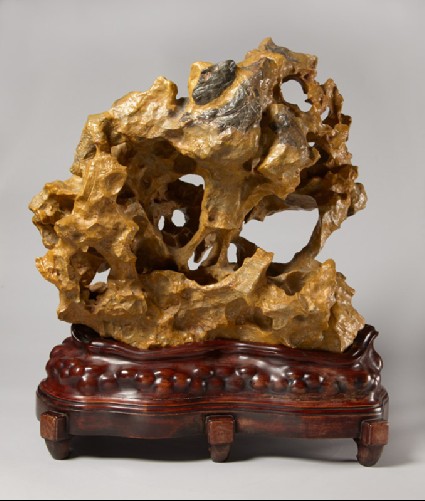Browse: 10610 objects
- Reference URL
Actions
A ‘yellow wax’ scholar’s rock
-
Description
A scholar’s rock is usually a naturally formed stone. It can be of any colour and size. Such stones were used to adorn a scholar’s desk in his studio and represented mountains, while acting as indoor versions of the magnificent natural stones that were installed in gardens and palaces. In the Tang dynasty (AD 618–907), a set of four principal aesthetic qualities for the rocks were developed: thinness, openness, perforations, and wrinkling.
Among the four major stone formations of scholar’s rocks in China, ‘yellow wax’ rocks come from the Lingnan region of China and are mainly composed of andesite with silica, therefore they are as hard as jade. The term ‘yellow wax’ may derive from their purity of colour and the glossy surface. Its golden caramel colour and natural perforated form rank this rock among the finest of this type.
Inscriptions on the back of the rock suggest that it may once have belonged to the Chinese collector Xu Shizhang (1889-1954).
-
Details
- Associated place
-
Asia › China › Lingnan region (probable find spot)Asia › China › Jiangnan region (probable find spot)
- Date
- inscribed 1936
- Associated people
-
Xu Shizhang (1889 - 1954) (said to have been owned by)
- Material and technique
- yellow andesite and silica, polished; wooden stand
- Dimensions
-
rock 35 x 50 x 43 cm (height x width x depth)
stand 16 x 48 x 26 cm (height x width x depth)
- Material index
- Technique index
- Object type index
- No. of items
- 2
- Credit line
- Presented, 2013.
- Accession no.
- EA2013.3
Past Exhibition
see (1)Location
-
-
Ground floor | Room 11 | Chinese Paintings

-
Ground floor | Room 11 | Chinese Paintings
Objects are sometimes moved to a different location. Our object location data is usually updated on a monthly basis. Contact the Jameel Study Centre if you are planning to visit the museum to see a particular object on display, or would like to arrange an appointment to see an object in our reserve collections.
© 2013 University of Oxford - Ashmolean Museum




